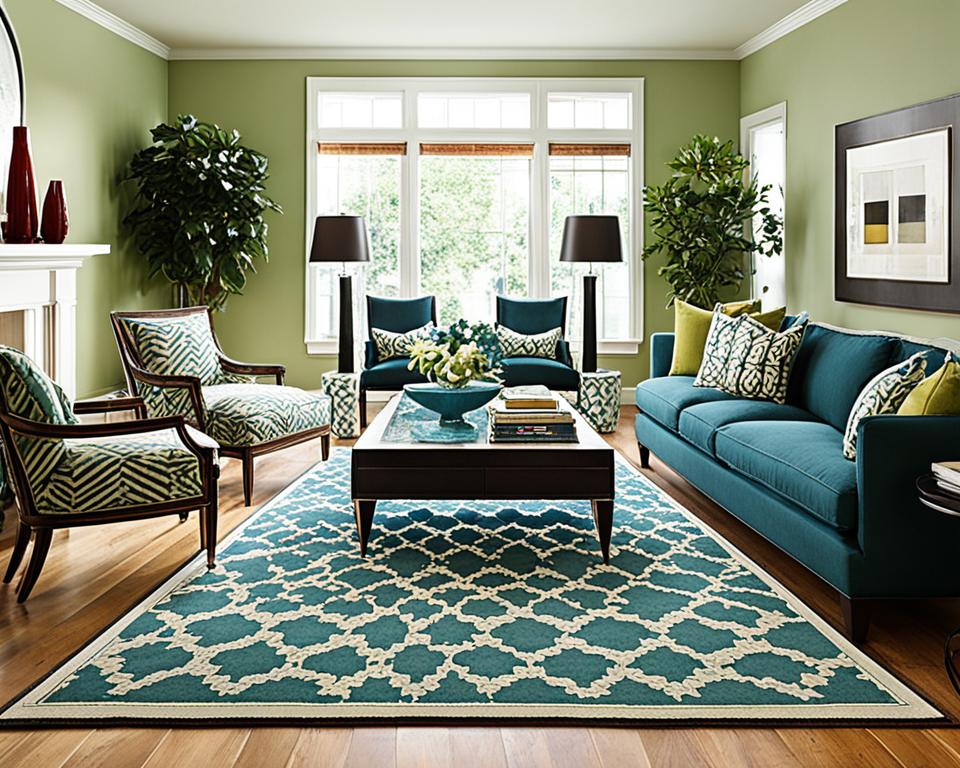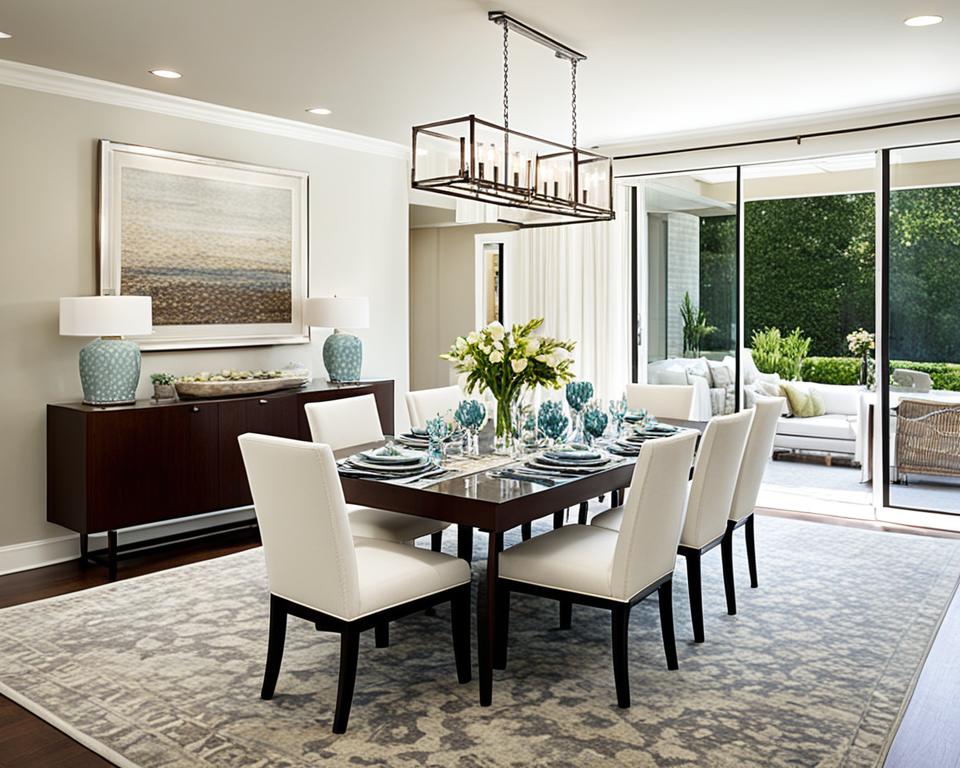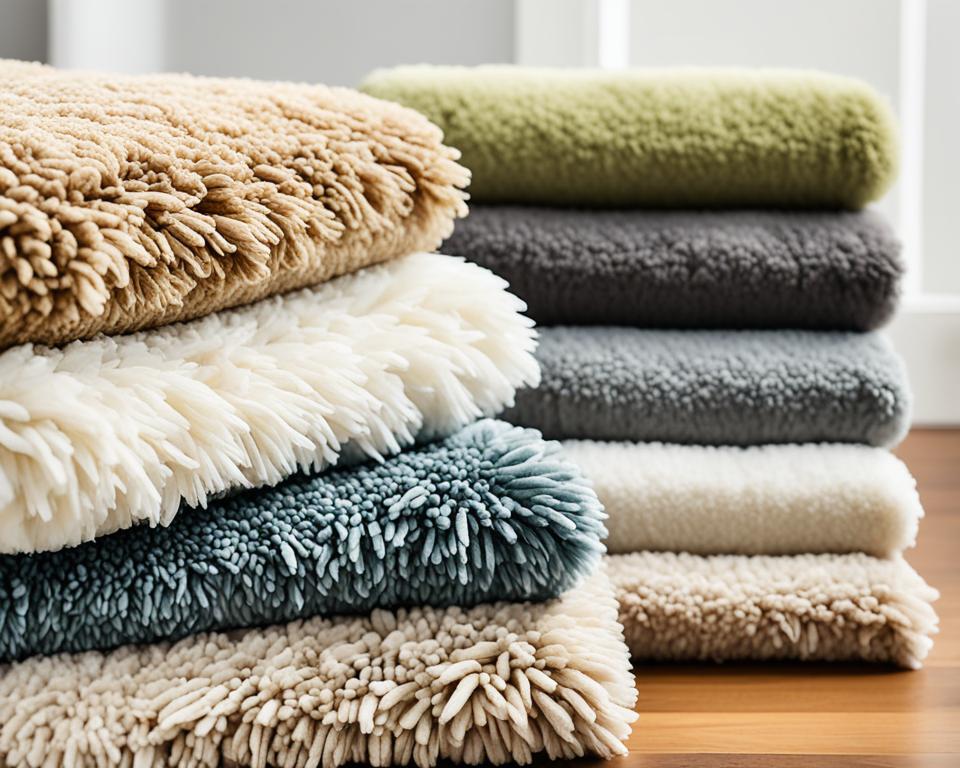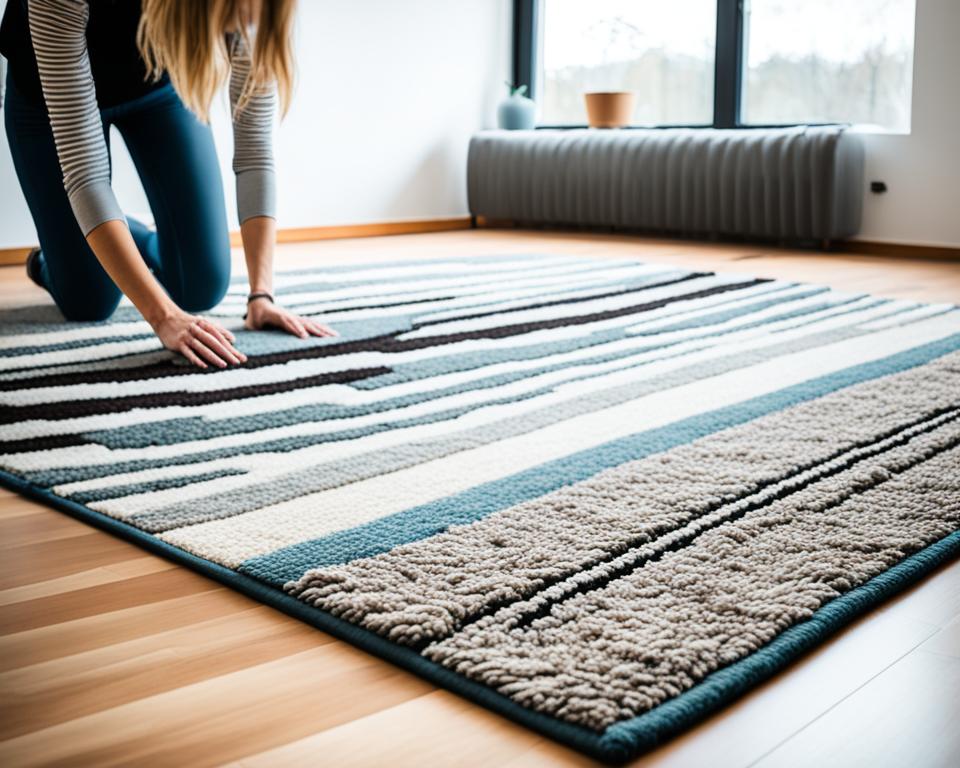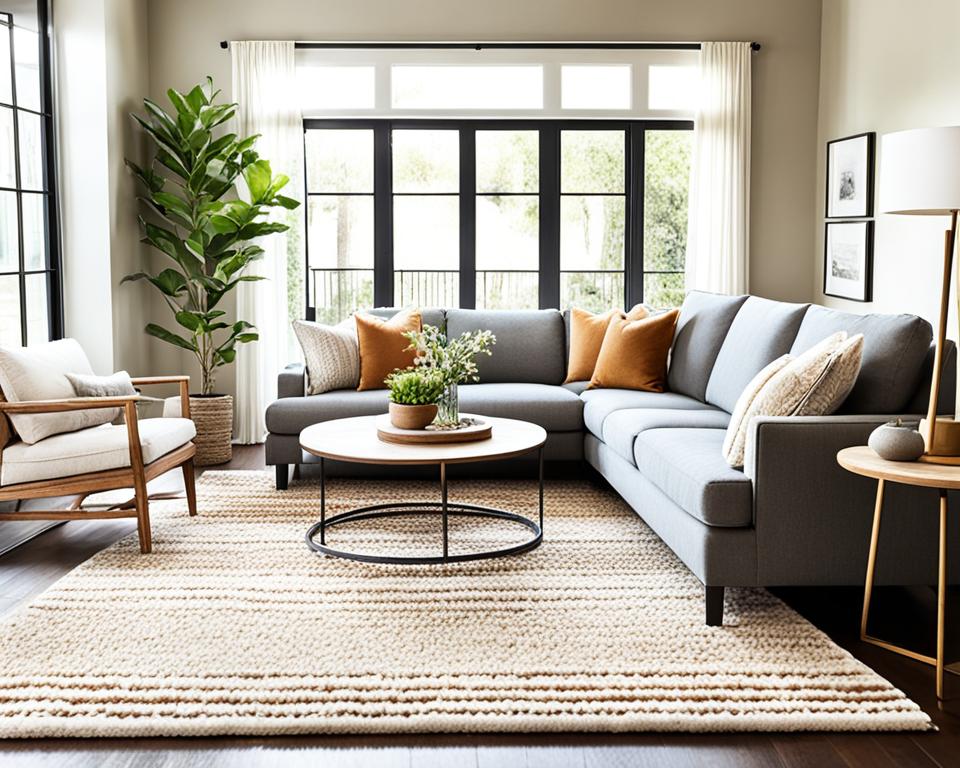Visualizing your living spaces and deciding on decor may already be part of your home-making process, but have you given thought to the strategic value of rug placement? A well-chosen rug can transform any room, and following ideal rug positioning strategies isn’t just about aesthetics—it’s about crafting an inviting atmosphere that starts from the ground up. Industry connoisseurs like Sally Pottharst, Jodie Fried, and Malin Glemme offer insightful rug placement tips that guide you towards not just a stylish space, but also one that feels “just right.”
When you’re piecing together the design puzzle of your home, the size and position of your rug should harmonize with the surrounding elements. Embracing larger rugs can make your rooms feel more expansive and warm, welcoming both you and your guests into a space that’s cohesive and thoughtfully curated. Especially in awkwardly shaped rooms, employing rugs with interesting shapes—like round or curved designs—can cleverly redirect the flow and feel of the environment.
A rug isn’t merely a floor covering; it’s an opportunity for you to weave together the disparate aspects of your room’s design. A burst of color, a daring texture, or a weave with character can make all the difference in constructing a seamless transition between your furnishings and your flooring. So, let the insights from our seasoned rug designers lead the way as you explore the realm of rug positioning guides to elevate your home’s character and comfort.
Key Takeaways
- Larger area rugs create a more inviting and unified space.
- Consider rugs with distinctive shapes for rooms with unusual proportions.
- Implementing a rug can bridge design elements in a room.
- Colorful, textural, and varied weaves can enhance the link from flooring to furniture.
- When in doubt about rug choices, seek advice from a design expert.
- Remember, the ultimate goal is to find a rug that you love and emphatically suits your space.
Understanding the Significance of Rug Size and Placement
When designing your living space, the impact of a rug’s size and placement cannot be understated. It’s the foundation that influences both the visual dynamics and the functionality of a room. Imbuing your home with a well-rounded sense of harmony involves more than selecting a beautiful rug; it means choosing one whose dimensions and position resonate with your existing decor and living habits. As you embark on the journey of finding your room’s perfect companion piece, keep in mind that it’s not just about what looks good—it’s about what feels right. Let’s dive into the factors that can help you master the best practices for rug placement.
Choosing the Right Size Rug for Your Space
Consider the golden rule of opting for the largest rug that will fit elegantly within your space. This choice can dramatically change the room’s ambiance, making it feel more expansive and inviting. For instance, experts from well-known rug manufacturers suggest leaving a bare minimum of 18 inches between the rug’s edges and the room’s baseboards to strike the perfect balance between coverage and room proportions. However, you shouldn’t shy away from a rug that steps outside the boundaries of a conventional rectangle—especially when dealing with irregular room shapes.
Considering Rug Placement for Maximum Effect
Optimizing rug placement extends beyond mere aesthetics. It’s about strategically arranging rugs effectively to create a cohesive and functional space. Your rug should serve as the link that ties together disparate elements within your room, setting the stage for furniture and creating a unified theme. This might involve positioning a colorful and textural rug to mediate the transition between hard flooring and plush furniture. In essence, the correct way to position rugs involves a combination of intuition and design theory—resulting in an arrangement that both captures the eye and serves practical needs.
The Art of Rug Placement in the Living Room
When you step into any living room, the first thing that might catch your eye is the rug—an anchor for the furniture and a defining feature of the space. Your living room is a hub of activity, a place for relaxation and socializing, and choosing the right rug layout can enhance the room’s character. Tiberio Lobo Navia, a design maestro, highlights how a strategically placed rug can delineate living zones, especially in open-concept homes, enhancing both form and function.
Indeed, your living room’s aesthetic appeal and sense of balance heavily rely on how rugs should be placed. It’s not just about finding a rug with a pattern and color that you love; the placement should also complement your lifestyle and the room’s layout. To help you navigate through various rug layout suggestions, experts propose flexible positioning aligned with your furnishings that could transform your space into an embodiment of luxury and practical comfort.
Anchoring Your Seating Arrangement with Rugs
Rugs do more than just adorn your floor—they play a pivotal role in unifying your living room’s seating arrangement. The concept of rug positioning goes hand in hand with the layout of your sofas and chairs. Ensuring that at least the front legs of your sofa rest on your rug can convey an atmosphere of inclusivity and purpose. This practice not only secures furniture but also pulls together diverse elements of your living area to create a coherent and inviting space.
Optimizing Rug Placement for Luxurious and Practical Living Spaces
For your rug positioning guide, remember that the size of the living room dictates the rug selection process. Cyrus Loloi, a name synonymous with exquisite rugs, suggests that in smaller to medium-sized rooms, a larger rug under just the front legs of the sofa can suffice. However, if your living room boasts more generous dimensions, a larger rug that frames the whole seating arrangement could add to the grandiosity of the space.
Another worthwhile consideration is the division of space within a room. Your living area may take on multiple roles—perhaps a sitting area and a play zone—and distinctive rug positioning can subtly mark these boundaries. Rugs offer a dynamic means to define these living zones without the use of walls, maintaining an open and airy feel while still signposting the different functionalities of your living room.
Embrace the art of rug placement and let it revolutionize your living room. With these tips, you can make informed choices on rug layout suggestions, ensuring that your rug not only enhances the decor but also complements your lifestyle. Allow your rug to be a testament to tasteful living, where every step you take within your living room feels like a step well placed.
Transforming Your Bedroom with Strategic Rug Positioning
Stepping into your sanctuary at the end of a long day, you seek comfort and a hint of luxury. Your bedroom, a canvas of personal expression, can be significantly enhanced by the correct way to position rugs. Through careful bedroom rug placement, each thread and weave contributes to a more harmonious and styled living space. Discover how the strategic placement of rugs can reinvent your bedroom’s aesthetic and elevate its comfort.
Enhancing Comfort and Style Beneath Your Bed
The first step towards transforming your bedroom is selecting a rug that harmonizes with your bed. Interior design experts advocate for a substantial portion of the bed—50 to 75 percent—to be mounted atop the rug. This not only gives off a plush, luxurious vibe but also creates a sense of intimacy and warmth within the space. How rugs should be placed greatly affects this, as the wrong positioning could disrupt the inviting ambiance you’re aiming for. Here’s a clear layout of suggested rug sizes to be paired with common bed dimensions:
| Bed Size | Recommended Rug Size | Placement Notes |
|---|---|---|
| Queen Bed | 8′ x 10′ | Centrally align rug with bed, extend from beneath |
| King Bed | 9′ x 12′ | Include nightstand in the rug area for added grace |
| Full Bed | 5′ x 8′ | Place rug perpendicular for optimized cozy emergence |
When considering the position, leading designers like Amber Lewis suggest placing the rug perpendicular to the bed, pulling it halfway under, which maximizes useable rug space and provides a soft surface upon waking. This approach ensures that with every step around your bed, your feet meet comfort and your eyes, a styled setting.
Creating Focal Points with Middle-Room Rugs
The strategic deployment of a middle-room rug can serve as an aesthetic anchor point, drawing the gaze centrally and making the enclosure come alive. In smaller bedrooms, this tactic not only emphasizes design but also sends a visual illusion of a larger space. Keep a consistent borderline between the rug and your bedroom walls to maintain this effect; an equitable distance is key here.
Your bedroom should be a testament to personal style, offering both visual splendor and tactile solace. Whether you’re positioning a rug beneath your bed or letting it stand out in the middle of your space, it’s the meticulous attention to detail that can transform your bedroom into a haven of plush comfort and understated elegance.
Optimizing Rug Placement for Elegant Dining
Envision yourself hosting a dinner party where every detail has been meticulously thought out, from the cutlery to the centerpiece. Now, imagine your dining room rug tying it all together, not just as an accessory but as a central feature of your dining experience. Executing dining room rug placement with precision is pivotal for achieving an elegant and refined ambiance. Let’s explore how you can master the art of arranging rugs effectively to complement your dining area.
At the heart of rug positioning in the dining area is the principle of proportionality and functionality. A rug under the dining table serves as a visual frame and a practical platform that grounds your dining set. To achieve this sublime balance, here’s a guide based on insights from design expert Malin Glemme:
| Dining Set Dimension | Minimum Rug Size | Visual and Practical Tips |
|---|---|---|
| 4-Seater Table | 6′ x 9′ | Keep all chairs on the rug, allow 24″ beyond table edges |
| 6-Seater Table | 8′ x 10′ | Extend rug 30″ from table for chair clearance when seated |
| 8+ Seater Table | 9′ x 12′ | Ensure rug accommodates chairs in and out of use |
Your rug positioning guide should not end with just choosing the right size. Centrally placing the rug ensures a cohesive look that invites diners into a unified space. To cater to the practical side of dining, your rug must extend at least a foot or two beyond the dimensions of the table, allowing chairs to be moved in and out smoothly without catching on the rug edges.
It is essential to note that while a beautiful rug can elevate your dining area’s decor, practical considerations such as easy-to-clean materials and durability should also influence your choice. By incorporating these elements, you take an indispensable step towards harmonizing the practical and aesthetic qualities of your dining experience. With careful thought and strategic placement, your dining room can be transformed into a space of beauty and grace, perfectly set for making memories over shared meals.
How Rugs Should Be Placed: Bedroom Layout Suggestions
Optimal bedroom rug placement is as crucial to your room’s beauty as the furniture you choose. Whether you’re unwinding for the night or stepping out of bed to greet the day, the rug underfoot is key to your comfort and the room’s aesthetic appeal. With a multitude of rug layout suggestions to consider, it is essential to identify the ideal size and positioning for your space. Aligning your rug placement with your bed size ensures a polished look and a harmonious overall design. Let’s explore some expert strategies to perfect the ideal rug positioning strategies within your bedroom.
Bearing in mind the spaciousness of your bedroom and the size of your bed, you’ll find that specific rug dimensions are more suitable than others. Complementing these elements with the right rug size not only enhances room proportion but also brings out the best in your bedroom’s design. Now, we’ll delve into the particulars of what rug sizes function best with various bed sizes and how runners might serve as a clever alternative for certain bedroom setups.
Rug Sizing for King and Queen Beds
For an elegant and well-balanced bedroom atmosphere, consider the correlation between your bed size and the appropriate rug area. For a resplendent queen bed, an 8′ x 10′ rug allows you to step onto softness from all sides, while a grander king-sized bed pairs well with a 9′ x 12′ rug to maintain luxurious proportionality. Here’s a reference to align your choice of rug to the dimensions of your bed:
| Bed Size | Ideal Rug Size | Placement Tip |
|---|---|---|
| Queen Bed | 8′ x 10′ | Extend beyond the bed’s perimeter |
| King Bed | 9′ x 12′ | Frame the bed, including side nightstands |
| Twin/Full Bed | 5′ x 8′ or smaller | Option to place at the footboard for compact rooms |
Innovative Placement Ideas for Runners and Smaller Rugs
In more diminutive bedrooms or for those preferring not to relocate heavy furniture, runners offer an appealing alternative. Laying runners on either side of the bed creates a pathway of comfort without overwhelming the room. This can also be a stylish solution when looking for rug layout suggestions that add a touch of sophistication to your sleeping quarters without the commitment of a large area rug. Versatility and creativity in rug placement can yield a unique and functional bedroom ambiance tailored to your personal taste and space constraints.
- Runners positioned along each side of the bed for ease and elegance.
- Center a smaller rug at the footboard for visual interest and tactile pleasure.
- Consider round or oval rugs to soften the bedroom’s geometric lines.
Your bedroom should serve as a refuge that reflects both your style and functional needs. With these insights into bedroom rug placement, sculpt a serene space uniquely, offering everyday luxury that starts right under your feet. Choose wisely, and let your rug be the silent yet significant foundation of your bedroom’s charm.
Strategies for Selecting the Ideal Rug Positioning in Unconventional Spaces
Discovering rug placement tips for non-traditional spaces can be quite exciting, almost like setting up a stage for each room to play its unique story. Whether it’s a tapered area, a room with multiple nooks, or a beautiful bay window nook, using rugs as a defining tool can transform these spots from awkward to extraordinary. The key is to deploy creative strategies that highlight the room’s best attributes while optimizing the flow and functionality.
Dealing with Award Room Shapes and Sizes
If your space challenges traditional decor norms with angles or alcoves that defy square or rectangular constrictions, you’re in for an artful adventure in arranging rugs effectively. Round rugs or those with fluid, organic edges can act as a soft counterpoint to harsh angles, infusing the area with a sense of balance. Designers often recommend the use of visually dynamic pieces that fit into the flow of the room like a puzzle piece, rather than attempting a force-fit with standard cuts.
Accentuating Room Features with Creative Rug Placements
When it comes to those unique features of a room that make it stand out—like a stately fireplace, a large picture window, or even an in-built bookcase—optimizing rug placement can go a long way. Aligning a rug to enhance these features rather than centering it can draw the eye and add to the charm of the space. Perhaps it’s an oblong rug that echoes the mantle’s length or a series of smaller rugs that lead a trail to a favored reading nook. The choice of rug can underscore your room’s architecture, turning what might be seen as a constraint into a highlight.
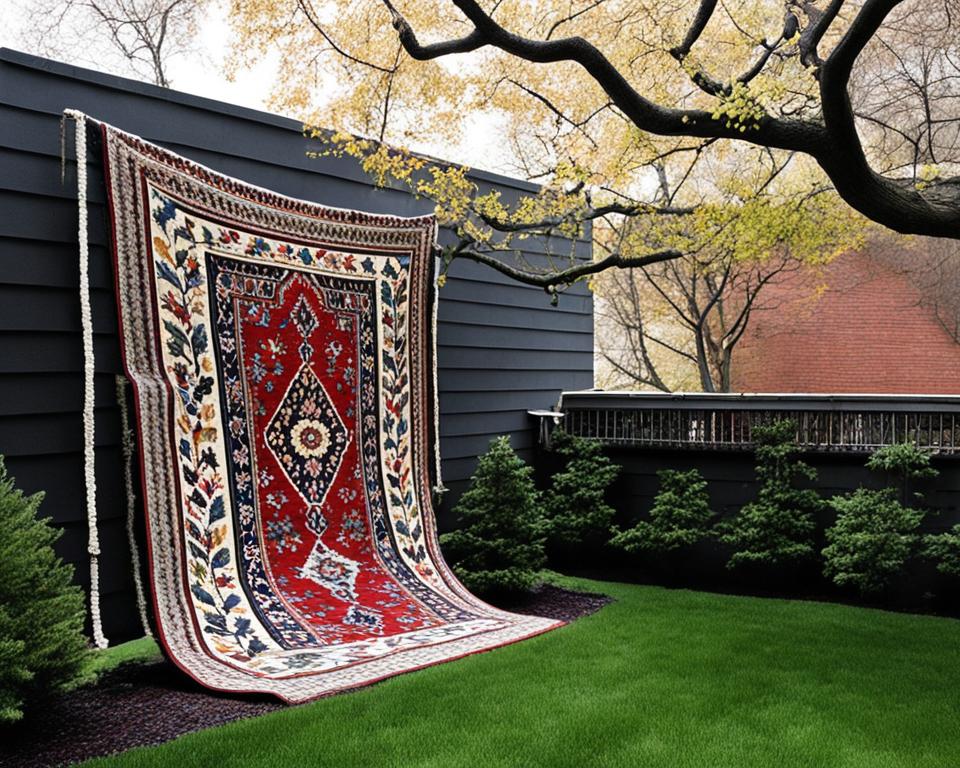
Rug Layout Tips for a Cohesive and Stylish Living Room
Envisioning a cohesive, stylish living room starts with the right foundation—your rug placement. Not only does the rug add a layer of comfort and warmth, but it also serves as a visual anchor that can tie together various design elements. Whether you’re working with a mid-century modern aesthetic or a more eclectic decor, the way you position your living room rug can profoundly impact the ambiance of the entire room.
Harmonizing Rug Placement with Room Decor
Harmony in living room decor stems from a thoughtful approach to combining color, texture, and proportion. Your rug should not stand as an isolated feature; rather, it should seamlessly integrate with the existing decor elements. A rug placed under a coffee table, extending comfortably to all seating areas, creates a sense of unity and completion. Furthermore, aligning your rug with other focal points in the room, like fireplaces or windows, can complement and enhance these architectural features.
Making a Statement with Overlapping Rug Designs
For those looking to add depth and richness to their living space, overlapping rugs is a technique worth considering. It’s not only bold but also adds a layer of texture and interest. Proper execution requires attention to proportion to avoid a cluttered look. Start with a neutral base rug that grounds the space, and then add a smaller, vibrant rug on top for contrast. Ensure that the overlap looks intentional and use shapes and colors that contribute to the overall cohesive look of your living room.
As you deliberate on living room rug placement, think about how traffic flows through the space and how each area will be utilized. Rug placement tips often suggest that the central seating area should have a larger rug to define it as the room’s main gathering place. Yet, don’t be afraid to break the rules when it comes to creating a personalized space. A rug should not only fit your aesthetic taste but also reflect your lifestyle and the character of your home. So, whether you’re laying down a singular, statement rug or layering several for a textured look, keep in mind the harmonizing potential of how rugs should be placed in your living room setup.
Best Practices for Rug Placement in Symmetry and Balance
Adhering to the principles of symmetry and balance is not just a matter of preference but taps into a deeper psychological resonance that many find satisfying. As you ponder over the best practices for rug placement, consider how symmetry can cultivate a serene and harmonious atmosphere in your home. These principles are essential for creating balanced living spaces that invite calm and centeredness. Let’s discover why maintaining symmetry in your rug arrangements is more than an aesthetic choice—it’s a strategy for well-being.
The Psychological Impact of Symmetrical Rug Arrangements
It’s human nature to seek out balance in our surroundings—a symmetrical rug placement resonates with our innate desire for order. Harmony in design can promote feelings of stability and wellness, making the choices you make in rug positioning significant beyond mere decoration. Thoughtful rug layout suggestions emphasize the placement that strikes a chord with our subconscious yearning for equilibrium in our living spaces.
Measuring for Proper Placement and Proportional Layouts
When it comes to optimizing your rug’s impact, precise measuring is paramount. To ensure proper placement and to keep your layout proportional, an essential guideline is to maintain a uniform gap of 10-20 inches from the rug’s edge to the walls. This spacing maximizes the visual impact, balancing the rug-sized presence with the room’s overall dimensionality, thereby supporting aesthetical integrity and highlighting your thoughtful approach to styling the space.
Keep in mind that your rug can act as a visual connector that ties together disparate furniture pieces and color schemes. It should nest the feet of several key pieces of furniture, without being neither too intrusive nor too insignificant. Aligning your rug placement with interior design guidelines facilitates a sophisticated yet inviting atmosphere that can define the core of a room. Whether it’s a bold palette to revamp a drab space or a neutral scheme to soothe the senses, allow your rug to serve as the canvas for building a room that speaks to you both visually and emotionally.
Remember, no matter how whimsical or reserved your design sensibilities may be, proportionality and symmetry are the cornerstones of any effective rug positioning guide. They bolster the fluidity of movement through your rooms and ensure that each piece of decor contributes to a cohesive story—beginning with your rug as the anchoring statement. By marrying these elements harmoniously, you set the stage for a home that’s as pleasing to the eye as it is comforting to the spirit.
Arranging Rugs Effectively: From Aesthetics to Functionality
Integrating a rug into your living space goes beyond enhancing the visual appeal; it’s a strategic design choice that amplifies a room’s functionality while radiating an undeniable allure. Arranging rugs effectively is not merely a decorative maneuver—it’s an extension of your lifestyle, safeguarding the areas that see the most foot traffic, shaping the flow of your space, and accentuating the existing decor. The art of how rugs should be placed is essential, crafting an environment that’s both striking and practical.
As you explore rug layout suggestions, consider how the selection and placement of your rug can echo your personality, infusing life into every nook and cranny of your home. A well-chosen rug should not only satisfy the eye with its color and pattern but also marry well with your room’s dimensions, thus avoiding the pitfall of a rug that’s too small or overwhelmingly large. Finding that sweet spot between extreme sizes ensures that your rug adds value to your daily activities, beyond its aesthetic qualities.
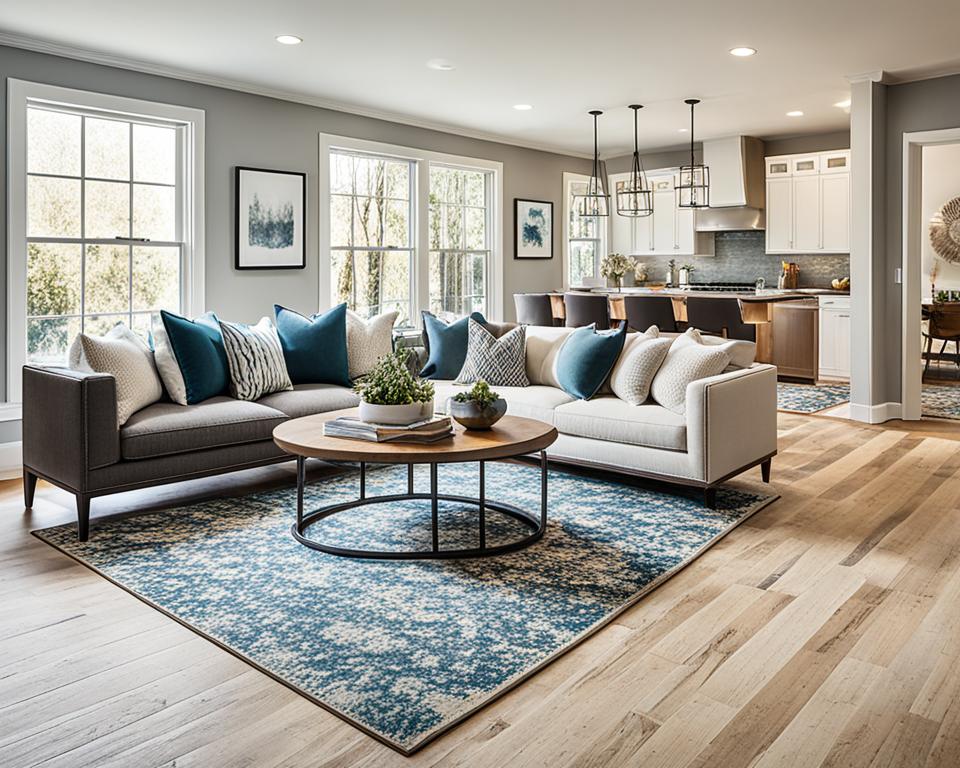
Let’s take a closer look at practical ways to leverage rug placement for an optimal blend of form and function:
- Identify the high-traffic zones in your space and select a rug that can not only withstand the wear but also offers a touch of comfort where it matters most.
- To create symmetry, the rug should be proportionate to the room, maintaining consistent spacing from the rug’s edge to the surrounding walls.
- Your choice of rug should resonate with the surrounding furniture and walls, knitting together disparate room elements to form a consonant visual narrative.
When your desired look demands more nuance or a room’s unique features call for a distinct approach, consider these insightful guidelines:
| Area of Consideration | Rug Placement Strategy | Functional Benefit |
|---|---|---|
| Living Area | Center a large rug under furniture groupings | Anchors the space, defines sections, and adds warmth |
| Bedroom | Position rug under bed, extending out on all sides | Softens first and last steps of the day, contributes to decor |
| Dining Room | Ensure rug encompasses all chairs even when pulled out | Protects flooring, adds elegance, promotes acoustic comfort |
| Entryway | Use a runner or small rug positioned for immediate impact | Makes a statement on entry, captures initial dirt and moisture |
In summary, your approach to arranging rugs effectively will significantly influence not just the ambiance but also the practicality of your living setting. Whether it’s creating a quiet nook for reading, framing your bedroom sanctuary, or pulling together a conversational lounge, allow your rug to be a fundamental layer in the design of your domicile—a silent but powerful testament to your exquisite taste and consideration for detail.
Conclusion
As we wrap up our exploration of the transformative power of rugs, it’s evident that optimal rug placement goes beyond mere decoration. Understanding how rugs should be placed is crucial—it’s about creating a cohesive look that completes your room and makes it more inviting. The size and orientation of your rug must be in dialogue with the dimensions of your room and the arrangement of your furniture. This harmony between elements is key to optimizing rug placement for both style and functionality.
Your approach to rug placement tips should be fluid, allowing for the unique dimensions and the character of your space to guide you. Be it elevating your dining experience, enriching your living room’s sense of space, or adding plush texture to your bedroom, careful placement is paramount. Always consider the interplay of textures, colors, and patterns, and how they connect to the larger design narrative of your home.
Don’t merely settle for the conventional; dare to experiment with various rug sizes, locations, and designs until you find the arrangement that resonates with your personal aesthetic. Whether you’re drawn to a grand statement piece that anchors your living room or a subtle accent that unites the decor, remember, the right rug in the right place can turn an ordinary room into an extraordinary one. So, let these insights inspire you, and watch as the pieces come together, crafting a home that delights with every step.
FAQ
How do I choose the right size rug for my space?
When selecting a rug size, aim for the largest rug that fits in the room without occupying the entire space. Ideal placement leaves a border of floor exposed, often around 10-20 inches from the walls. Consider the furniture layout and choose a rug that either fits all the furniture or at least the front legs of seating pieces.
What are the best practices for rug placement in a living room?
For a luxurious and practical living space, the living room rug should anchor the seating area. All furniture, or at least the front legs of the primary sofas and chairs, should be placed on the rug. Ensure the rug is centered in the room and proportional to the space available.
How should I position a rug in my bedroom for optimal comfort and style?
The rug should extend beyond the sides and end of the bed, ensuring comfort when stepping out of bed. Ideally, 50 to 75 percent of the bed should sit on the rug. Consider using a large rug under the bed or runners on either side for a cozier feel.
What’s the ideal way to place a rug in a dining room?
Center the rug under the dining table and choose a size that allows all chair legs to stay on the rug when pulled out for seating. A rule of thumb is to have the rug extend 24-36 inches beyond the table on all sides for both aesthetics and functionality.
How do I handle rug placement for rooms with unconventional layouts?
For unique room shapes, consider round or irregularly shaped rugs to harmonize the space. Position the rug to highlight architectural features or use it to define specific areas. Don’t be afraid to try different placements that complement the room’s angles and curves.
Can I overlap rugs in my living room to create a stylish space?
Yes, overlapping rugs is a great way to add depth and interest to your living room. Ensure the proportions and color schemes are well-considered so the look remains cohesive. Using rugs of varying textures and sizes can contribute to a dynamic living area.
Why is symmetry important in rug placement?
Symmetrical arrangements tend to be visually pleasing, creating a sense of balance and harmony within the room. Properly measuring for rug placement can ensure that both the rug and the furniture contribute to a symmetrical look that is inviting and cohesive.
What should I consider about rug placement to enhance a room’s functionality?
Aside from aesthetics, think about traffic patterns and how the rug will protect flooring in high-use areas. Choose a rug that supports the room’s function—whether that’s defining spaces, adding warmth, or reducing noise. Balance the size and positioning to improve the space’s overall utility.

